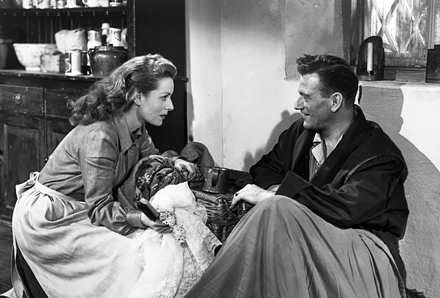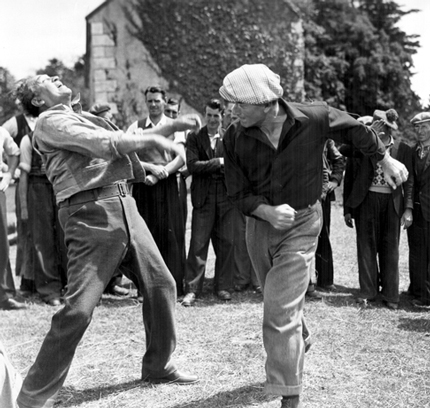
 |
|
|
|
Fans have been howling about the absence of a good disc version of John Ford's The Quiet Man ever since 2002, when Artisan video released a pitifully substandard DVD. Excellent Blu-rays of Paramount titles are the stock in trade of Olive Films, and last year they expanded to the related Republic Pictures library. We've been the beneficiaries, with the release of fine HD copies of Republic-owned greats like High Noon, Johnny Guitar and Invasion of the Body Snatchers. The Quiet Man was originally a Technicolor production, which had us concerned that the new Blu-ray might still have problems -- a true restoration for a 3-strip feature is prohibitively expensive. Happily, I have very good news to report on the quality of the new disc, below. 
The Quiet Man is as personal a production as the very personal filmmaker John Ford ever made. Detractors may point to its hyper-sentimentalized image of Ireland, or complain that Ford gives too many acting parts and creative roles to his relatives or relatives of his key associates. It's been said that to work in Mexican films one had to be "in" with one of three key people; in Hollywood, marrying one of John Ford's daughters didn't hurt either. This may be an Irish-American dynasty film, but it's a fond favorite, an old-fashioned crowdpleaser. The story is a dream vision of an Irish-American's repatriation to Eire, the land of his birth. Champion Boxer Sean "Trooper" Thornton (John Wayne) returns to the town of Innisfree where his ancestors once lived, to retire. He immediately falls in love with beautiful colleen Mary Kate Danaher (Maureen O'Hara) and begins an amusing country engagement, chaperoned by the colorful Michaleen Flynn (Barry Fitzgerald). But a serious roadblock surfaces in the person of Kate's brother Red Danaher (Victor McLaglen). Convinced that the champion boxer is a coward because he won't fight, Red refuses to part with Kate's dowry, without which she stubbornly refuses to consider herself married. Trying to sort out the problem are local priest Father Peter Lonergan (Ward Bond), and the widow Sarah Tillane (Mildred Natwick), who has her cap set for Red. The question on everyone's lips is, "Why won't the famous boxer fight?" This time out, John Ford creates his Irish fantasy world not within an American Cavalry framework, but back in the real Irish countryside. The longish film is a short story opened up to take its time celebrating an idealized vision of rural Ireland. One doesn't have to be Irish to see the stereotypes -- despite the fact that the traits being exaggerated are authentic. The Quiet Man received an ambivalent Irish reception. Some Irish critics were appalled by characters that drink, brawl and spout incessant blarney. Mysterious boxer Sean Thornton is revealed to be a reborn-by-conscience pacifist in a dramatic flashback, but the film's real stretch is how such a sweet & civilized John Wayne could ever have fought in the ring. Sean talks about how tough things were back in the ring in Pittsburgh, but in all other respects boxing is honored as a noble and uplifting sport. Even the local minister has a boxing background. For kids, the film's basic tension is waiting for the Duke to finally stop acting so gentlemanly and HIT somebody. Remember that the majority of John Wayne movie posters show him hitting somebody; it was his screen persona. John Wayne is often listed as giving his best performance here. His Sean is charismatic, thoughtful, and restrained. He's the patient straight man for a couple of dozen colorful characters, and handles the job with distinction. Maureen O'Hara is still the great beauty and has energy and personality to spare. An authentic Irish Colleen, she was always the perfect movie mate for Wayne, and played with him often enough that kids assumed they were married. Her Mary Kate is a sexy and argumentative mule, forcing Sean to prove her love to him by fulfilling a Dowry ritual that to her represents the institution of marriage. It's a credible-enough device, even though it does put her love for Sean on a strange footing: rite first, and mate second. As a substitute for more... touchy problems in marriage it's perfect. All Sean need do to fulfill his wife's dreams is to behave like a barbarian for an afternoon. 
Ford must have had the time of life taking a working vacation in the land of his ancestry, filling a movie with the broadest, most endearing stereotypes of Irishmen ever seen. It's hard to guess if real Irish people would be flattered or offended. There's Ward Bond's earthy Father Lonergan, fanatic about his fishing and solicitous in his attentions to everyone's private problems -- even Mrs. Thornton brings her bedroom predicaments to him, which they discuss in what sounds like very frank, if incomprehensible, Gaelic. Lonergan, knowing his parish is almost completely Catholic, rallies his congregation to line the parade route when the Protestant Bishop visits, so that the local minister, a good friend to all, won't be recalled. This vision of Catholic - Protestant relations is the film's most bittersweet Irish fantasy. Barry Fitzgerald's Michaleen Flynn is wonderfully funny as a guide and a chaperone ("No, pitty-pat, if you please!"). His slow burn of astonishment at the sight of the Thornton's broken bed is priceless. More in line with Ford's usual knockabout slapstick drinkin' & brawlin' is Victor McLaglen's broad Red Danaher, who might as well be Mack Swain in a Charlie Chaplin film. McLaglen's boorish antics are more amusing here than in the Cavalry pictures. Ford's semi-comic sagas of fighting and boozing were just comedy to him. As kids we took it all as how you were supposed to behave when you grew up, at least until we discovered that alchohol was basically poison, and getting hit hurt. Having a chair broken over your head, or even being punched a few times, is more likely to kill a person than cause them to make funny Popeye faces. Ford's films weren't any more irresponsible than anybody else's in Hollywood, and the carefree way the actors sling those shot-glasses around while spilling whiskey all over the bar is mighty attractive, manly-behavior wise. In the bar where people are forever singing, getting drunk and threatening to fight, Ford's slyest joke is to have an English gentleman quietly reading, oblivious to all the life & excitement around him. In the cast, I really enjoy the little-known but marvelous Jack MacGowran (Cul-de-Sac, The Fearless Vampire Killers, The Exorcist) as Red Danahaer's sniveling cohort. That said, all the bits appear to be filled by relatives of Ford, Wayne, and O'Hara. O'Hara's brother, Charles FitzSimons, later produced Sam Peckinpah's first western, The Deadly Companions. Some take Ford's straight-on directing style, with scenes composed in masters and coverage that often resembles a silent film, as evidence of petrification. Baloney. He's just direct and unfussy, and isn't afraid to let a scene be what it is. Ford likes to see acting play out in uninterrupted wide masters as opposed to close-up coverage that robs the scene of context. He doesn't mind letting his exteriors embrace postcard-pretty scenics either. When he's after a strong cinematic effect, he gets it. If he'd been bouncing the camera all over the place looking for dynamic ways to shoot each scene, there'd be no contrast in the brief boxing flashback, which hits like a brick thrown through the screen. Close-ups in Ford count for something. Even a showy director like Orson Welles admired Ford's restraint and economy. 
Perhaps Ford was a big cornball, but critics often don't realize that the comedy in shows like The Quiet Man was meant to be tongue-in-cheek. The setpiece where Sean finally cuts loose and drags his wife back from the train station, to begin a cross-country marathon donnybrook with his ox-like brother-in-law, is extremely effective, and very funny. Everybody gets what they want. Mary Kate recovers her dowry and self-respect. Red gains a friendly brother-in-law: punch somebody out, you're an okay guy, it's a Hollywood law. Sean finally gets to sleep with his wife. It's a fairly sexy ending for this family film when the couple rushes back to their cottage. The film ends with Ford's multiple-farewell filmic curtain call, something he repeated for several of his nostalgic pictures, not just the ones filmed in glorious Blarney-Rama. Critics that think he's corny should lighten up; he's just acknowledging the theatrical artifice of his own style. Olive Films' Blu-ray of The Quiet Man is going to please fans of John Ford and John Wayne. Promoted as 're-mastered in HD from a 4K scan of the original negative," the show has good color, excellent detail and an overall clean look. Faces can be a little bright but contrast is good overall. Artisan's 2002 DVD was a disaster that few of us bothered to watch twice. It can now be forgotten. Glenn now slides out on a limb -- I'm going to guess that the restoration people that worked on The Quiet Man did not work from a conventional original negative, as Technicolor movies are sourced in three original B&W negatives. The source could have been an excellent photochemical composite element made from those three negatives. I say 'excellent' because I see little trace of color fringing caused by misalignment, when the three strips have shrunk (shrunken?) at different rates. The Quiet Man could also have been digitally re-composited from the three negatives, as was done by Criterion for last month's Blu-ray of Heaven's Gate. It's a possibility, but Olive's publicity makes no mention of anything like this being done. That hardly matters when we see the result. I'm personally reminded of the I.B. Tech print I saw at UCLA about 1976, with Winton Hoch in attendance, boast, boast. The colors are saturated, favoring dark greens. Much of the movie seems to have been shot under overcast skies, which only makes the hues seem more alive. Victor Young's music score, which in the main is a collection of Ford's favorite Irish songs, is very clear on the soundtrack. Olive Films recognizes that The Quiet Man is no ordinary release in that the fans that want it tend to be crazy about it. It's John Ford's equivalent for It's a Wonderful Life, as imagined in the mind of a filmmaker whose heart is back in the Old Country. To that end the disc includes a good 1992 featurette docu hosted by a very young Leonard Maltin. He covers the interesting background to the filming of the movie. Masochists curious to see how bad earlier video releases looked can find out with this docu... the clips are pretty accurate. Also included is an insert pamphlet containing a reprint of a Joseph McBride chapter from his biography Searching for John Ford. McBride examines the film from several angles I'd never considered, such as the fact that early scripts involved Sean Thornton in militant IRA activities. Endorsing rebellion in the political atmosphere of 1952 was a commercial no-no, so the IRA content was reduced to a few funny remarks from Fitzgerald's Michaeleen Flynn. One dialogue line had to be blooped: when a toast is made to "Nationalist freedom", the word "nationalist" has been wiped from the track. 1
On a scale of Excellent, Good, Fair, and Poor,
The Quiet Man Blu-ray rates:
Footnotes:
1. It's fairly clear that Sergio Leone's Giù la testa borrowed its subplot of James Coburn's dark past in the IRA from John Ford's The Informer, and took its vision of Ireland as a romantic heaven from this movie. Is Sean Thornton the "Sean" that is John Mallory's best friend in the Leone film?
Reviews on the Savant main site have additional credits information and are often updated and annotated with reader input and graphics. Also, don't forget the 2011 Savant Wish List. T'was Ever Thus.
Review Staff | About DVD Talk | Newsletter Subscribe | Join DVD Talk Forum |
| ||||||||||||||||||